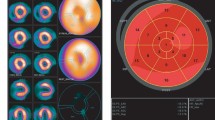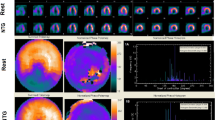Abstract
It is clinically important to determine the myocardial viability of regional wall motion abnormality segments in patients with acute myocardial infarction (AMI). The purpose of this study was to ascertain the ability and value of a combination of speckle tracking echocardiography (STE) and low dose dobutamine stress echocardiography (LDDSE) for the evaluation of viable myocardium in patients with AMI. Forty-two hospitalized patients with AMI and left ventricular systolic dysfunction (left ventricular ejection fraction <50 %) were underwent STE in conjunction with LDDSE and dual isotope simultaneous acquisition single photon emission computed tomography (DISA-SPECT). Percutaneous coronary intervention (PCI) was performed subsequently in all patients. STE was used to measure radial, circumferential, and longitudinal end-systolic strain and peak systolic strain rate. The movement of each segment was observed by routine echocardiography 1, 3, and 6 months after PCI, and its improvement over time was the criterion of viable myocardium. The sensitivity, specificity and accuracy of DISA-SPECT for the assessment of viable myocardium were 83.6, 74.4, and 80.7 %, respectively. Among the radial, circumferential, and longitudinal strain and strain rate parameters, only longitudinal strain (LS) and longitudinal strain rate (LSr) at rest and LDDSE emerged as independent predictors of viable myocardium, When combining LS and LSr at LDDSE, the sensitivity, specificity and accuracy for the assessment of viable myocardium rose to 89.8, 90.2 and 89.9 %, respectively. The sensitivity of STE in conjunction with LDDSE was similar to DISA-SPECT for detecting viable myocardium in patients with AMI, but the specificity and accuracy of STE performed with LDDSE were higher than DISA-SPECT.






Similar content being viewed by others
References
Blessberger H, Binder T (2010) Non-invasive imaging: two dimensional speckle tracking echocardiography-basic principles. Heart 96:716–722
Geyer H, Caracciolo G, Abe H et al (2010) Assessment of myocardial mechanics using speckle tracking echocardiography: fundamentals and clinical applications. J Am Soc Echocardiogr 23:351–369
Skulstad H, Urheim S, Edvardsen T et al (2006) Grading of myocardial dysfunction by tissue Doppler echocardiography: a comparison between velocity, displacement, and strain imaging in acute ischemia. J Am Coll Cardiol 47:1672–1682
Lyseggen E, Skulstad H, Helle-Valle T et al (2005) Myocardial strain analysis in acute coronary occlusion: a tool to assess myocardial viability and reperfusion. Circulation 112:3901–3910
Sawada S (2000) Dobutamine echocardiography for detection of viable myocardium in ischemic cardiomyopathy. Echocardiography 17:69–77
Smart SC, Stoiber T, Hellman R et al (1997) Low dose dobutamine echocardiography is more predictive of reversible dysfunction after acute myocardial infarction than resting single photon emission computed tomographic thallium-201 scintigraphy. Am Heart J 134:822–834
Kushner FG, Hand M, Smith SC Jr et al (2009) 2009 focused updates: ACC/AHA guidelines for the management of patients with ST-elevation myocardial infarction (updating the 2004 guideline and 2007 focused update) and ACC/AHA/SCAI guidelines on percutaneous coronary intervention (updating the 2005 guideline and 2007 focused update): a report of the American College of Cardiology foundation /American Heart Association task force on practice guidelines. Circulation 120:2271–2306
Cerqueira MD, Weissman NJ, Dilsizian V et al (2002) Standardized myocardial segmentation and nomenclature for tomographic imaging of the heart: a statement for healthcare professionals from the Cardiac Imaging Committee of the Council on Clinical Cardiology of the American Heart Association. Circulation 105:539–542
Youden WJ (1950) Index for rating diagnostic tests. Cancer 3:32–35
Renkin J, Wijns W, Ladha Z, Col J (1990) Reversal of segmental hypokinesis by coronary angioplasty in patients with unstable angina, persistent T wave inversion, and left anterior descending coronary artery stenosis. Additional evidence for myocardial stunning in humans. Circulation 82:913–921
Bolli R (1998) Basic and clinical aspects of myocardial stunning. Prog Cardiovasc Dis 40:477–516
Allman KC, Shaw LJ, Hachamovitch R, Udelson JE (2002) Myocardial viability testing and impact of revascularization on prognosis in patients with coronary artery disease and left ventricular dysfunction: a meta-analysis. J Am Coll Cardiol 39:1151–1158
Tamaki N, Kawamoto M, Tadamura E et al (1995) Prediction of reversible ischemia after revascularization. Perfusion and metabolic studies with positron emission tomography. Circulation 91:1697–1705
Slart RH, Bax JJ, van Veldhuisen DJ, van der Wall EE, Dierckx RA, Jager PL (2006) Imaging techniques in nuclear cardiology for the assessment of myocardial viability. Int J Cardiovasc Imaging 22:63–80
Fukuchi K, Katafuchi T, Fukushima K et al (2000) Estimation of myocardial perfusion and viability using simultaneous 99mTc-tetrofosmin-FDG collimated SPECT. J Nucl Med 41:1318–1323
Slart RH, Bax JJ, van Veldhuisen DJ et al (2006) Prediction of functional recovery after revascularization in patients with chronic ischemic left ventricular dysfunction: head-to-head comparison between 99mTcsestamibi /18F-FDG DISA SPECT and 13 N-ammonia/18F-FDG PET. Eur J Nucl Med Mol Imaging 33:716–723
Slart RH, Bax JJ, de Boer J et al (2005) Comparison of 99mTc –sestamibi/18FDG DISA-SPECT with PET for the detection of viability in patients with coronary artery disease and left ventricular dysfunction. Eur J Nucl Med Mol Imaging 32:972–979
Hillis GS, Mulvagh SL, Gunda M, Hagen ME, Reeder GS, Oh JK (2003) Contrast echocardiography using intravenous octafluoropropane and real-time perfusion imaging predicts functional recovery after acute myocardial infarction. J Am Soc Echocardiogr 16:638–645
Mor-Avi V, Koch R, Holper EM et al (2008) Value of vasodilator stress myocardial contrast echocardiography and magnetic resonance imaging for the differential diagnosis of ischemic versus nonischemic cardiomyopathy. J Am Soc Echocardiogr 21:425–432
Pierard LA, deLandsheere CM, Berthe C, Rigo P, Kulbertus HE (1990) Identification of viable myocardium by echocardiography during dobutamine infusion in patients with myocardial infarction after thrombolytic therapy: comparison with positron emission tomography. J Am Coll Cardiol 15:1021–1031
Bax JJ, Wijns W, Cornel JH, Visser FC, Boersma E, Fioretti PM (1997) Accuracy of currently available techniques for prediction of functional recovery after revascularization in patients with left ventricular dysfunction due to chronic coronary artery disease: comparison of pooled data. J Am Coll Cardiol 30:1451–1460
Vanoverschelde JL, Melin JA (1999) Metabolic imaging and contractile reserve for assessment of myocardial viability: friends or foes? J Nucl Cardiol 6:458–461
San Román JA, Sanz-Ruiz R, Ortega JR et al (2008) Safety and predictors of complications with a new accelerated dobutamine stress echocardiography protocol. J Am Soc Echocardiogr 21:53–57
Dandel M, Hetzer R (2009) Echocardiographic strain and strain rate imaging—clinical applications. Int J Cardiol 132:11–24
Mondillo S, Galderisi M, Mele D et al (2011) Speckle-tracking echocardiography: a new technique for assessing myocardial function. J Ultrasound Med 30:71–83
Bansal M, Jeffriess L, Leano R, Mundy J, Marwick TH (2010) Assessment of myocardial viability at dobutamine echocardiography by deformation analysis using tissue velocity and speckle-tracking. J Am Coll Cardiol 3:121–131
Li DY, Hao J, Xia Y et al (2012) Clinical significance of low dose dobutamine stress real-time myocardial contrastst echocardiography in detection of vialble myocardium. J Clin Ultrasound 40:272–279
Galli M, Marcassa C, Bolli R et al (1994) Spontaneous delayed recovery of perfusion and contracion after the first 5 weeks after anterior infarction: evidence for the presence of hibernating myocardium in the infracted area. Circulation 90:1386–1397
Greenbaum RA, Ho SY, Gibson DG, Becker AE, Anderson RH (1981) Left ventricular fibre architecture in man. Br Heart J 45:248–263
Torrent-Guasp F, Buckberg GD, Clemente C, Cox JL, Coghlan HC, Gharib M (2001) The structure and function of the helical heart and its buttress wrapping. I. The normal macroscopic structure of the heart. Semin Thorac Cardiovasc Surg 13:301–319
Rademakers FE, Rogers WJ, Guier WH et al (1994) Relation of regional crossfiber shortening to wall thickening in the intact heart. Three-dimensional strain analysis by NMR tagging. Circulation 89:1174–1182
Chan J, Hanekom L, Wong C, Leano R, Cho GY, Marwick TH (2006) Differentiation of subendocardial and transmural infarction using two dimensional strain rate imaging to assess short-axis and long-axis myocardial function. J Am Coll Cardiol 48:2026–2033
Becker M, Hoffmann R, Kuhl HP et al (2006) Analysis of myocardial deformation based on ultrasonic pixel tracking to determine transmurality in chronic myocardial infarction. Eur Heart J 27:2560–2566
Reant P, Labrousse L, Lafitte S et al (2008) Experimental validation of circumferential, longitudinal, and radial 2-dimensional strain during dobutamine stress echocardiography in ischemic conditions. J Am Coll Cardiol 51:149–157
Wakura K, Okamura A, Koyama Y et al (2010) Automated assessment of myocardial viability after acute myocardial infarction by global longitudinal peak strain on low-dose dobutamine stress echocardiography. Circ J 74:2158–2165
Gallagher KP, Osakada G, Matsuzaki M, Miller M, Kemper WS, Ross J Jr (1985) Nonuniformity of inner and outer systolic wall thickening in conscious dogs. Am J Physiol 249:H241–H248
Acknowledgments
This work was supported by the Academic Degrees Committee and the Department of Education of Jiangsu province (CXLX11_0731) and Xuzhou scientific technology subject, Jiangsu, China (XF11C063).
Conflict of interest
None.
Author information
Authors and Affiliations
Corresponding author
Rights and permissions
About this article
Cite this article
Gong, L., Li, D., Chen, J. et al. Assessment of myocardial viability in patients with acute myocardial infarction by two-dimensional speckle tracking echocardiography combined with low-dose dobutamine stress echocardiography. Int J Cardiovasc Imaging 29, 1017–1028 (2013). https://doi.org/10.1007/s10554-013-0185-y
Received:
Accepted:
Published:
Issue Date:
DOI: https://doi.org/10.1007/s10554-013-0185-y




